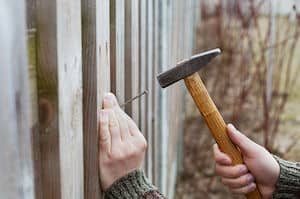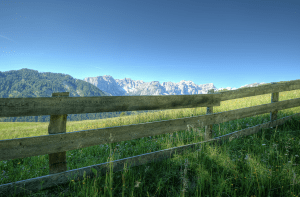What Causes a Fence to Lean? 6 Possible Causes and Solutions
A leaning fence can be a huge nuisance to anyone who owns the property. What’s even more frustrating is not knowing the reasons why this has started to happen. If you’re wanting to get to the bottom of why your fencing has started to lean, here are the most common causes of fence leaning you should be aware of.
6 Causes and Solutions for a Leaning Fence:
1. Holes That Are Too Shallow
2. Posts That Have Gone Rotten
3. Improperly Installed Posts
4. As the Result of Weather/Climate Conditions
5. Aging Materials
6. Natural Inclines
7. Termite Damage
Now that you’re familiar with the common causes of fence leaning, it’s important to examine each one carefully so you can come to a confident decision about what is causing your own fence to lean.

1. Leaning Due to Pilot Holes That Are Too Shallow
When it comes to fences, what you don’t see is just as if not more important than what you see. If you start with any kind of lazy installation of your fence posts, there will most certainly be problems later on. When installing fence posts, the depth of your pilot holes needs to be calculated correctly.
If too shallow, the fence will begin to lean. If too deep, you will have trouble with height adjustments. The depth also depends on how tall you want the end result to be. The taller the fence, the deeper the pilot hole. If this important step is overlooked, these posts will eventually have to be replaced, which will end up costing you a lot of time and money.
How to Fix: Dig deeper post holes and reset your fence posts.
Utilize a Post Hole Auger to reset your fence posts.
2. Leaning Due to Posts That Have Gone Rotten
If you find that some of your fence posts are rotting, it is most likely because they have been exposed to moisture for a long period of time. Even if you have used concrete, water will sometimes seep into the ground and be drawn towards the base. The concrete will act as a sponge and absorb all of that moisture.
Depending on what kind of soil you use to bury your posts, it might be a better alternative in the long run. Another way your posts can experience wood rot is if they are regularly exposed to a water source such as a sprinkler or heavy rain. The posts will absorb the water, and it will sink down to the bottom. This can even cause the base to swell so much that it will cause the concrete base to crack.
How to Fix: Replace rotten fence posts with new posts and then stain or paint the fence to create a weather proof barrier.

3. Leaning Caused By Improperly Installed Posts
If a fence has been installed improperly, it is usually because the initial fencing system shopping was done without the proper research and investment. Before anything begins with a fence installation, there needs to be a proper plan in place.
How to Fix: Remove current fence posts and reinstall properly.
This starts by looking over the location where the fence will be installed and assessing where your property starts and ends. After that, you need to look up the zoning laws for your area and if there are any safety codes you need to adhere to.
Another important step in the planning process is to make sure ahead of time that you know exactly where any wires or underground pipes are. After all of this is done, then you can start looking into researching the proper materials and tools for beginning this kind of project. If any of these things are overlooked, it can lead to a lot of mistakes during and after the installation has taken place.
Utilize post hole diggers to properly install your posts.
4. Leaning As the Result of Weather/Climate Conditions
Your fence has to go through quite a lot in order to stay upright for such a long period of time. If you live in an extremely cold climate, there is a chance that your fence could become very rigid and even brittle.
If the pressure is applied in these conditions, your fence could experience cracks that will weaken its overall integrity. On the flip side of that, if you live in a climate that is extremely hot, the material you have selected will expand. If there isn’t enough room for this kind of expansion, you will begin to see serious warping.
Another cause of damage to a fence can be from extreme weather conditions. For example, some light breezes won’t give you any problems, but if there are strong winds, your fence can easily become structurally unstable.
How to Fix: Remove bent or broken fence posts. Dig new pilot holes and reinstall posts.
 5. Leaning Due to Aging Materials
5. Leaning Due to Aging Materials
Unfortunately, there are quite a few materials used in fence installations that will eventually start to show signs of age and weathering. Wood, for example, is a very reliable and natural material, but it also one that is susceptible to hot and cold climates.
As mentioned before, constant exposure to moisture can eventually cause severe rotting, therefore compromising the structural integrity of the fence. Another big issue can be vulnerability to termite damage. If not treated, termites are able to eat through the bases of your posts, causing you even more problems.
Another material that is vulnerable to damage is vinyl fencing. While this material is for the most part low maintenance, it can’t withstand all conditions. After severe weather, you need to be sure to examine all vinyl fencing and check for cracks. Once this is done, an assessment can be made on how much work needs to be done to do proper repairs.
Aluminum, similarly to vinyl is pretty much maintenance-free, but that doesn’t mean that it is invisible either. This material is known to shift as a result of soil that has shifted around the posts during a severe storm. Because of the nature of this material, you will most likely need to hire a professional fencing company to help you remove or repair this type of fencing.
How to Fix: If your fencing material has become to old to function properly it is time to look at building a new fence. You may be able to salvage some of the material but a new fence may be the best remedy.
6. Leaning Caused by Natural Inclines
One of the silent killers of a stable fence is slopes or inclines that are overlooked or ignored. An incline that is even very subtle is able to have a big impact on how straight your fence will stand over time.
One of the ways to ensure your fence stays uniform on a slope is to be sure and adjust the panels as needed to have a straight and clean final product you can be proud of. Finding a fence that is able to be racked will allow you to have a fence that will stay upright and make sure the top of your fence stays completely even. Paying special attention to details will give you a sturdy fence that stays upright on the steepest of slopes.
How to Fix: Level the ground and reinstall fence posts.
7. Termite Damage
Other Ways to Fix Your Leaning Fence
Thankfully, there are solutions to fix the problem of a leaning fence. This is good news for anyone thinking that their fence needed to be replaced completely. These steps will depend on the material and what the initial cause of your leaning fence is, but here are a few things you can do to address the problem:
Remove Posts That Are Leaning
A good place to start is to assess which posts are leaning and to go ahead and dig them out. Remove any cement that has been used, and then make sure you adjust the fence so that it stands upright.
Once this has been done, move on to adding a new concrete base within the pilot hole, and re-install the post if it isn’t damaged. Make sure that the surface of the concrete is inclined so that any water is directed away from the post itself.
Remove Damaged Portions Of The Fence
If you are using wood fencing material, rotting has probably happened underneath the ground rather than above ground. In order to address this issue, you want to make sure that the fence is braced correctly so that it can stand upright. Once this is done, remove the dirt and concrete from around any rotted area, and began to cut out the damaged section. After this is finished, you will want to place a new section of the post into where you have just removed the damaged section, and bolt it to the end of the existing post.
After all of this has been completed, finish everything off by creating a new concrete mixture, and pouring it around the base. Once again, make sure that the surface of the concrete is inclined so that any water is directed away from the post itself.
Bolster Rails The Already Exist
Any fence will have two rails. A top rail, and a bottom rail. If installed correctly, your fence should have a rail for every 24 inches of height to ensure stability. With any fence that is unstable, a good thing to do is to go ahead and bolster the rails that already exist, by installing a third or fourth rail below or above the existing ones.
This ensures increased stability and will prevent any further warping or gaps. Bolstering the rails will also keep your fence from bowing or sagging over long periods of time.
Call A Professional Fencing Company
And finally, one of the best things you can do if you are having problems with a leaning fence is to call your local fencing company. Fixing a fence the right way requires a lot of knowledge and experience. Deciding to hire a professional, you are able to ensure that you will not sustain any injuries and that you will not unintentionally make the problem worse than it already is.
Most fencing companies will be able to repair any kind of fencing that there is, even if they didn’t do the initial installation of the original fence. You can rest assured that your fence is in good hands when professionals are in charge of getting the job done.



